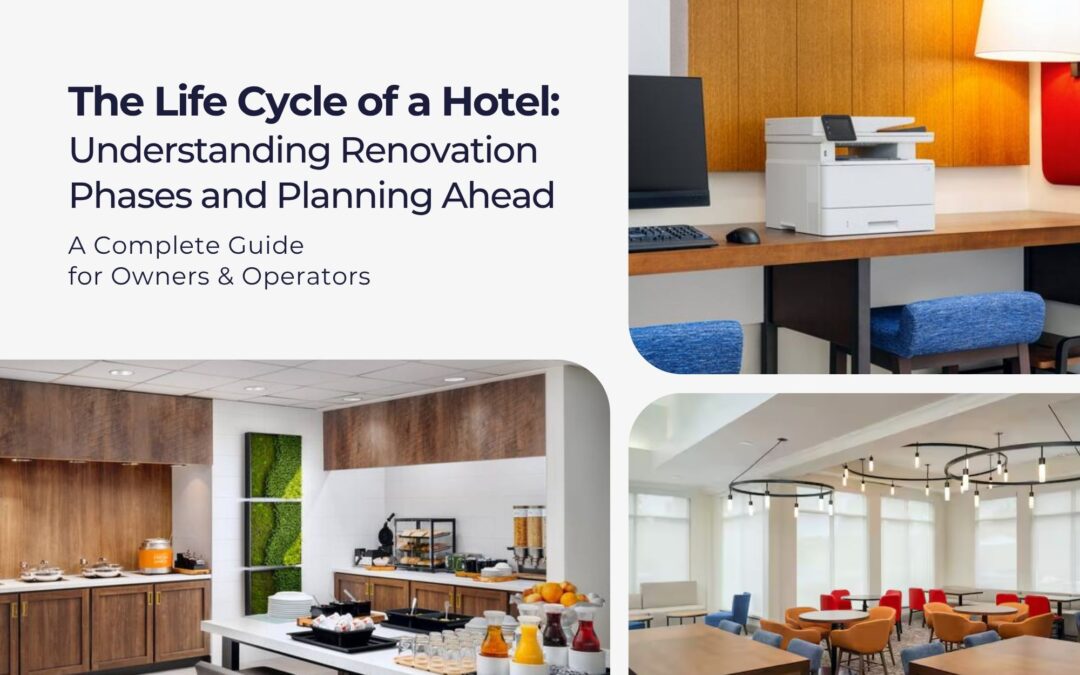Hotels are living, breathing assets. From the moment a property opens its doors, the clock starts ticking on wear, guest expectations, and evolving brand standards. That’s why hotel owners and property managers often think of hotels in terms of a life cycle, where each phase requires planning, investment, and, most importantly, the renovation phase of the hotel.
At Amerail Systems, we’ve guided hoteliers through every stage of this cycle. With over 40 years of nationwide hotel renovation experience, we know that strategic planning at each phase ensures your property stays competitive, compliant, and profitable.
Why Renovation Is Built Into the Hotel Life Cycle
Unlike other commercial real estate assets, hotels have constant guest traffic and brand requirements that accelerate the need for updates. Rooms, lobbies, and exteriors are used every day, meaning wear and tear shows faster.
Renovations are not just cosmetic; they:
- Maintain brand compliance with Property Improvement Plans (PIPs)
- Improve guest satisfaction and review scores
- Protect asset value for owners and investors
- Increase RevPAR and occupancy rates
- Support energy efficiency and operational savings
In short: renovation isn’t optional in the hotel life cycle, it’s essential.
The Phases of a Hotel’s Life Cycle
Most hotels go through similar renovation phases, regardless of brand or size. Understanding these phases helps property managers and owners budget, schedule, and plan ahead.
1. Opening & Ramp-Up Phase (0–3 Years)
In the early years after opening, everything is fresh, from the paint to the carpet. This is the stabilization period, where management focuses on building occupancy, refining operations, and marketing the property.
Key Considerations in This Phase:
- Preventive maintenance to protect new finishes
- Establishing a long-term maintenance schedule
- Monitoring guest feedback for early signs of improvement needs
At this stage, renovations aren’t required, but proactive upkeep sets the tone for the property’s future performance.
2. Minor Refresh Phase (3–6 Years)
By year three to five, visible wear and tear begins to show — especially in high-traffic areas like lobbies, corridors, and guestrooms. Brands often require a soft goods renovation, focusing on items with shorter lifespans.
Typical Upgrades Include:
- New carpet, wall coverings, and paint
- Furniture reupholstery or replacement
- Updated bedding and draperies
- Minor lighting upgrades
This refresh helps maintain guest satisfaction and brand consistency, while extending the life of larger building systems and fixtures.
3. Major Renovation Phase (7–10 Years)
At this point, a property usually requires a comprehensive renovation. Franchise brands often issue updated PIPs (Property Improvement Plans), requiring owners to modernize interiors and sometimes reimagine exteriors to match evolving brand standards.
Typical Renovation Scope:
- Full guestroom remodels (case goods, fixtures, flooring, paint, lighting)
- Lobby and front desk redesigns
- Corridor and elevator area upgrades
- Exterior façade refresh, signage, and porte cochere work
- Window replacement and energy-efficiency improvements
This phase often has the greatest impact on ROI. A well-planned renovation can dramatically improve curb appeal, guest satisfaction, and RevPAR.
4. Rebranding or Conversion Phase (12–20 Years)
By this stage, owners may choose to rebrand or may have to fulfill a new PIP from the brand they’re currently with. This often involves significant upgrades to meet new brand standards.
Common Projects in This Phase:
- Complete lobby and public space transformations
- Exterior reimaging with new finishes and signage
- Guestroom layout adjustments to fit new brand requirements
- Energy-efficient upgrades (windows, HVAC, insulation)
- Structural reconfiguration, such as porte cochere expansion
Partnering with an experienced hotel renovation company is critical here, as brand conversions require strict compliance, efficient execution, and guest-sensitive construction.
5. Long-Term Asset Management Phase (20+ Years)
For older properties, owners face a choice: continue investing in renovations or consider redevelopment. At this stage, hotels often need significant mechanical, electrical, and plumbing (MEP) upgrades, along with comprehensive aesthetic overhauls to remain competitive.
Potential Projects:
- Full renovations of guestrooms and bathrooms
- Replacement of elevators, roofing, and major building systems
- Façade recladding or EIFS repairs
- Code compliance upgrades (ADA, fire safety, etc.)
Strategic investment at this stage can extend the life of a property for another decade or more, but requires careful cost-benefit analysis.
Planning Ahead: How Hotel Property Managers Can Stay Ahead of Renovation Cycles
Hotel renovations can feel disruptive, but with advance planning, they become a manageable part of the property’s life cycle. Here are practical tips:
1. Use Guest Feedback as an Early Indicator
Monitor online reviews and guest surveys. Frequent mentions of outdated décor, worn carpets, or drafty windows are red flags that it’s time to act.
2. Align with Brand Standards Early
Stay in communication with your franchise representatives. Understanding brand updates early allows you to plan phased renovations instead of rushed, costly updates.
3. Budget for Continuous Improvement
Set aside a capital reserve fund (typically 3–5% of annual revenue) for ongoing renovations and PIP fulfillment. This ensures you’re financially prepared when renovation cycles hit.
4. Schedule Renovations Strategically
Plan major projects during off-peak seasons to minimize guest disruption and revenue loss. Phased construction (floor by floor, wing by wing) helps maintain occupancy.
5. Partner with a Design-Build Renovation Firm
A design-build approach provides single-source accountability, faster timelines, and value-engineered solutions, making renovations smoother, more efficient, and less disruptive.
The Amerail Advantage in Hotel Renovations
With over 2,400 hotel renovations completed nationwide, Amerail Systems has been part of every stage in the hotel life cycle. Our services include:
- PIP Fulfillment with direct brand coordination
- Interior and Exterior Renovations tailored to your property
- Hotel Repair Services, including EIFS and window replacement
- Design-Build Renovation for faster, more efficient projects
- Guest-Sensitive Crews to keep your hotel operational during construction
Our mission is simple: We aim to WOW. From planning and budgeting to project execution, we help hotels maximize their investment and stay competitive at every phase of the life cycle.
Renovation as a Competitive Advantage
The life cycle of a hotel isn’t just about age. It’s about anticipating change and planning ahead. Every phase brings opportunities to improve guest experience, align with brand standards, and protect long-term asset value.
By embracing renovations as a strategic advantage, property managers and owners can keep their hotels fresh, competitive, and profitable for decades to come.
When it’s time to plan your next renovation phase, partner with a hotel renovation company that has the expertise, relationships, and guest-sensitive processes to deliver results that last. At Amerail Systems, we don’t just renovate hotels. We help shape their future. Contact us today to get started.


